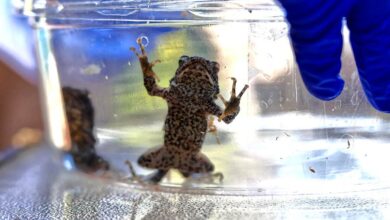Can Humans Communicate with Animals Using Artificial Intelligence?
Knowing what a Dog Says when Barking is Something that can be Close to Being Achieved. We tell you About the Latest Advances in Science.

Photo: Pexels
LatinAmerican Post | Moisés Campos
Listen to this article
Leer en español: ¿Pueden comunicarse los humanos con los animales usando Inteligencia Artificial?
To find out if humans can communicate with animals through Artificial Intelligence, the project known as the Earth Species Project (ESP) is currently being developed.
This project is based in California, United States, since 2017, and its growth is due to donations from Reid Hoffman, co-founder of LinkedIn, who also leads this organization and who has a special interest in decoding non-human languages.
What is pursued with this project of communicating animals and humans with Artificial Intelligence?
The Earth Species Project team is not very large, consisting of only ten people. However, they are very convinced of the potential they have for understanding non-human languages and thus optimizing links with other species.
They develop this in order to strengthen their ability to protect these species and improve the relationship they have with the environment. This relationship has reached such a point that, if no action is taken in this regard, the Earth will be becoming a place not fit to be inhabited.
Therefore, for the Earth Species Project team, the main goal is to modify our ecological footprint through the development of technologies focused on the conservation of biology and diversity, specifically in communication with the species that inhabit it.
How does the project of communicating animals and humans with Artificial Intelligence work?
The Earth Species Project works by means of open source software (Open-source software) where, in a collaborative and non-profit manner, scientific and technological studies are carried out that seek to understand the needs of non-human species, mainly animals.
It is based, primarily, on the advances that have already been made in Artificial Intelligence that allow the translation of languages without the need for a dictionary. In other words, the idea is to take these advances as a basis for also, occasionally, being able to translate animals into a language that humans are capable of understanding.
Similarly to the operation of other Artificial Intelligence projects, the Earth Species Project would obtain its knowledge through computer learning that seeks to evaluate communication and other behaviors that are common within the animal kingdom. In this way, analyze those that allow them to create a society and communicate with each other.
Examples of this are the dances that bees do to communicate or the song of birds, which have always functioned as forms of communication between species.
It is also expected that, through this technology, humans can communicate with animals through certain frequencies or vibrations and even songs that provoke behavior models in the species to generate a new way of language. In this way, humans will be able to better understand the needs of animals and thus help in their survival.
Basic aspects to communicate animals with humans with Artificial Intelligence
Some fundamental aspects to be considered in the project of communicating animals with humans through Artificial Intelligence are highlighted below:
Current use of machine learning
Today, there has been a growth in the use of machine learning to handle the large volumes of data collected by contemporary animal sensors.
According to Elodiw Briefer, an associate professor who discusses vocal communication in animals and mammals, machine learning is now being used to understand animal communication. Briefer co-developed an algorithm capable of determining, through pig grunting, whether the animal is happy or sad.
Also read: Apps of religion to find the 'middle orange'
Another project, from DeepSqueak, studies the ultrasonic sounds of rats in order to determine if they are under stress. There is also CETI (Cetacean Translation Initiative), which works with whale communication through machine learning.
Application for the entire animal kingdom
The Earth Species Project (ESP) organization emphasizes that its objective is different, since it is not aimed at deciphering the communication of a single species, but of all of them.
ESP plans to first decipher animal communication using machine learning, then make its discoveries available to everyone.
According to Aza Raskin, co-founder and president of ESP, its goal is to strengthen human bonds with other living species, while seeking to facilitate their protection using machine learning, in order to decipher non-human communication.
He also added that the translation algorithms ESP is developing are meant to apply to all biology, from worms to whales.
Forms of non-verbal communication
To communicate, dolphin trainers make signs with their hands. The trained dolphins exchange sounds before going out, turning around and raising their tails, creating a new trick of their own and performing it.
Raskin pointed out that this does not prove that there is a language, but simply that, if they had access to a linguistic communication tool, everything would have been much easier.
In addition, he assures that, similar to humans, animals also have different forms of non-verbal communication, such as bees that do a special dance to indicate to each other that they should perch on a certain flower.
Advances in experimental algorithms
Despite the seemingly insurmountable challenges facing the group, the project has made some progress, such as an experimental algorithm that can theoretically determine which individual in a large group of animals is the one making noise.
A second algorithm can supposedly produce imitated animal calls to communicate directly with them. In other words, it is as if Artificial Intelligence spoke the language, even though what it means is not yet known.
Skepticism for new technology
Although this type of research generates very interesting expectations, not everyone is excited in the same way about the power of Artificial Intelligence.
For example, Robert Seyfarth, from the University of Pennsylvania, believes that technology can be useful in solving problems such as identifying an animal's vocal repertoire. However, there are other areas, such as discovering the meaning and function of vocalizations, where he is skeptical of getting much input.





